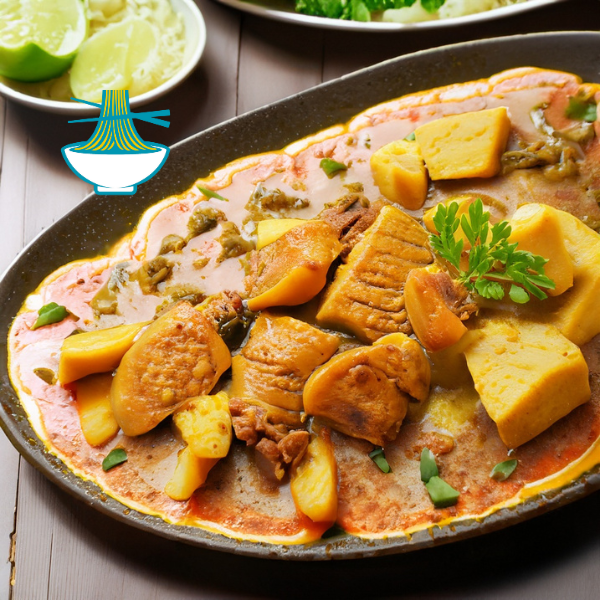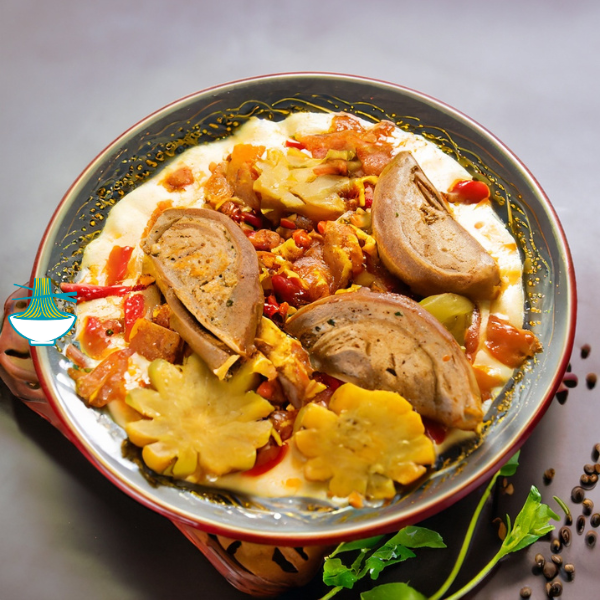Afghan Aushak, also known as leek or chive dumplings, is a beloved dish that combines light, savory flavors with a rich cultural heritage. Traditionally, Aushak consists of delicate dumplings filled with nutrient-packed leeks or chives, which are rich in vitamins A, C, and K, along with manganese and folate. These ingredients support immunity, eye health, and brain function. The dish is topped with a savory tomato and meat sauce, offering essential nutrients like iron and vitamin B12 for energy production and muscle repair. A refreshing garlic yogurt dressing adds probiotics and antimicrobial properties, enhancing digestion and gut health. Aushak, commonly enjoyed during festive gatherings, especially during Ramadan, is a perfect balance of taste, tradition, and nutrition, making it a truly nourishing meal.

Ingredients:
- 1 lb. ground beef or lamb
- 1 large onion, finely chopped
- 2 cloves garlic, minced
- 1 tsp. ground cumin
- 1 tsp. ground coriander
- Salt and pepper, to taste
- 1 package of wonton wrappers (or homemade pasta dough)
- 1 cup plain yogurt
- 1 cup canned crushed tomatoes
- 2 tbsp. vegetable oil
- Fresh cilantro or parsley for garnish
Substitutes for Ingredients:
Plant-Based Yogurt:
- Replace traditional yogurt with plant-based yogurt made from coconut, almond, or soy milk for a vegan-friendly option or for those with lactose intolerance.
- It’s best to choose unsweetened plant-based yogurt to maintain a similar flavor profile.
Homemade Dough Instead of Store-Bought Wrappers:
- To make homemade dough, mix 2 cups of all-purpose flour with 1/2 teaspoon of salt. Gradually add 3/4 cup of water and knead until a smooth dough forms. Let it rest for 20-30 minutes, then roll it out on a floured surface and cut into small 10×10 cm squares.
Instructions:
1. Prepare the Meat Filling:
- In a large skillet, heat the vegetable oil over medium heat. Add the chopped onion and garlic and sauté until onions turn translucent and garlic becomes fragrant. Add the ground beef or lamb, breaking it up into small pieces, and cook until browned. Stir in cumin, coriander, salt, and pepper. Cook for another 2-3 minutes to let the spices bloom. Remove from heat and allow to cool.
2. Assemble the Dumplings:
- Place about a teaspoon of the cooled meat mixture in the center of each wonton wrapper. Fold the wrapper in half to form a triangle, pinching the edges to seal. Continue this process until all the meat filling is used.
3. Cook the Dumplings:
- Bring a large pot of salted water to a boil. Gently add the dumplings and cook for about 4-5 minutes or until they float to the surface and are cooked through. Drain and set aside.
4. Prepare the Sauce:
- In a small bowl, mix together the plain yogurt with the crushed tomatoes. Optionally, season with a little salt and garlic for added flavor.
5. Serve the Aushak:
- Arrange the cooked dumplings on a serving platter. Drizzle the yogurt-tomato sauce over the top. Garnish with fresh cilantro or parsley for a burst of color and freshness.
Tips and Tricks for Cooking Aushak
Perfect Onion and Garlic Sauté:
- Sauté onions until they turn translucent for a mild flavor, but if you prefer a sweeter taste, cook them slightly longer until golden brown. Be careful not to burn the garlic, as it can become bitter.
Enhance Meat Filling Flavor:
- For deeper flavor, toast the cumin and coriander in a dry pan for 1-2 minutes before adding them to the meat. This brings out their natural aroma and richness.
Sealing the Dumplings:
- To ensure the dumplings stay sealed while cooking, moisten the edges of the wrapper with water before pinching them together. Press firmly to avoid leaks during boiling.
Prevent Dumplings from Sticking:
- After boiling, lightly toss the dumplings in a bit of oil to prevent them from sticking together before adding the sauce.
Test for Dough Doneness:
- Boil a single dumpling as a test before cooking the entire batch. This ensures the dough’s thickness and cooking time are just right.
Yogurt Sauce Consistency:
- If the yogurt sauce is too thick, thin it out with a splash of water or lemon juice for a smoother texture. Adding a pinch of salt enhances its flavor.
Garnishing for Extra Flavor:
- Top with fresh cilantro or parsley, a sprinkle of red chili flakes, or a drizzle of olive oil for added color and taste.
Notes:
- Aushak can also be made vegetarian by filling the dumplings with sautéed leeks or chives instead of meat.
- For extra richness, you can add a dash of garlic powder or lemon juice to the yogurt sauce.
- Traditionally served as a main course, Aushak can also be enjoyed as an appetizer or side dish.
Explore Afghan Ashak, a culinary gem known as Aushak Afghan Dumplings, blending rich flavors and cultural heritage. Filled with leeks or onions, they're paired with creamy garlic yogurt and savory sauces, making every bite a taste of Afghan tradition.
Frequently Asked Questions About Aushak (Afghan Leek Dumplings)
What are the traditional methods for making the dough instead of using store-bought wrappers?
- A simple explanation of how to make homemade dough and shape it.
Can Aushak be frozen after preparation?
- Tips for freezing the dish and storing it for a longer time.
What are other types of sauces that can be used?
- Suggestions for alternative sauces that add new flavors.
Can the dish be made healthier?
- Suggestions like reducing the oil or using lean ground meat.
What is the history of this dish in Afghan cuisine?
- A brief overview of the dish’s origin and how it has evolved over time.
Nutritional Values:
Nutrition Facts (per serving):
- Calories: 285
- Total Fat: 10g
- Saturated Fat: 3g
- Cholesterol: 45mg
- Sodium: 510mg
- Total Carbohydrates: 27g
- Dietary Fiber: 2g
- Sugars: 3g
- Protein: 20g
Here is the breakdown of the nutrition facts for the ingredients listed in your Aushak recipe:
1. Ground Beef or Lamb (1 lb.)
- Calories: Approximately 1200-1300 calories (depending on fat content)
- Carbohydrates: Negligible (less than 1 gram)
- Protein: Around 90-100 grams
- Fat: Approximately 90-100 grams
- Sodium: Varies based on seasoning, typically 70-100 mg
- Cholesterol: About 300-400 mg
- Vitamins and Minerals: Contains vitamin B12, iron, zinc, and selenium
Benefit: Good source of high-quality protein, iron, and essential vitamins and minerals.
2. Onion (1 large, finely chopped)
- Calories: About 45-50 calories
- Carbohydrates: Around 10-12 grams
- Protein: Approximately 1 gram
- Fat: Negligible (less than 1 gram)
- Sodium: Around 5-10 mg
- Cholesterol: None
- Vitamins and Minerals: Rich in vitamin C, vitamin B6, folate, potassium, and manganese
Benefit:: Provides antioxidants, supports immune health, and adds flavor to dishes.
3. Garlic (2 cloves, minced)
- Calories: About 10-15 calories
- Carbohydrates: Around 2-3 grams
- Protein: Approximately 0.5 grams
- Fat: Negligible (less than 1 gram)
- Sodium: Around 1-2 mg
- Cholesterol: None
- Vitamins and Minerals: Contains vitamin C, vitamin B6, manganese, and selenium
Benefit: Offers antioxidants, supports heart health, and has antimicrobial properties.
4. Ground Cumin (1 tsp.)
- Calories: Approximately 8-10 calories
- Carbohydrates: Around 1 gram
- Protein: Negligible (less than 1 gram)
- Fat: Approximately 0.5-1 gram
- Sodium: Around 2-3 mg
- Cholesterol: None
- Vitamins and Minerals: Contains iron, magnesium, and calcium
Benefit: Adds flavor and may aid digestion.
5. Ground Coriander (1 tsp.)
- Calories: Approximately 5-7 calories
- Carbohydrates: Around 1 gram
- Protein: Negligible (less than 1 gram)
- Fat: Negligible (less than 1 gram)
- Sodium: Around 1-2 mg
- Cholesterol: None
- Vitamins and Minerals: Contains vitamin C, vitamin K, and manganese
Benefit:Adds flavor and may have antioxidant properties.
6. Salt and Pepper (to taste)
- Calories: Negligible
- Carbohydrates: Negligible
- Protein: Negligible
- Fat: Negligible
- Sodium: Varies based on quantity used
- Cholesterol: None
- Vitamins and Minerals: No significant nutrients
Benefit: Enhances flavor but should be used in moderation, especially salt.
7. Wonton Wrappers (1 package)
- Calories: Approximately 200-250 calories (varies by brand and size)
- Carbohydrates: Around 40-50 grams
- Protein: Around 5-7 grams
- Fat: Around 1-3 grams
- Sodium: Varies based on brand, typically 200-300 mg
- Cholesterol: Varies based on ingredients, typically 0-5 mg
- Vitamins and Minerals: Contains small amounts of calcium, iron, and potassium
Benefit: Provides carbohydrates for energy, but should be consumed in moderation due to potential high sodium content in some brands.
8. Plain Yogurt (1 cup)
- Calories: Approximately 120-150 calories (varies by fat content)
- Carbohydrates: Around 10-15 grams
- Protein: Around 8-12 grams
- Fat: Around 4-8 grams (varies by fat content)
- Sodium: Around 80-120 mg
- Cholesterol: Around 10-30 mg
- Vitamins and Minerals: Contains calcium, vitamin D, vitamin B12, and probiotics (if live cultures)
Benefit: Good source of protein, calcium for bone health, and beneficial bacteria for gut health (if live cultures).
9. Canned Crushed Tomatoes (1 cup)
- Calories: Approximately 70-80 calories
- Carbohydrates: Around 15-20 grams
- Protein: Around 2-3 grams
- Fat: Negligible (less than 1 gram)
- Sodium: Around 300-400 mg
- Cholesterol: None
- Vitamins and Minerals: Rich in vitamin C, vitamin K, potassium, and antioxidants like lycopene
Benefit: Provides vitamins, minerals, and antioxidants, especially lycopene which is linked to heart health.
10. Vegetable Oil (2 tbsp.)
- Calories: Approximately 240-260 calories
- Carbohydrates: Negligible
- Protein: Negligible
- Fat: Around 28-30 grams
- Sodium: Negligible
- Cholesterol: None
- Vitamins and Minerals: No significant nutrients
Benefit: Adds fat for cooking and flavor but should be used in moderation due to high calorie content.
Please note that these nutrition facts are approximate values and can vary depending on the specific brand and type of ingredients used.
Overall, Aushak is a delicious and satisfying dish that is easy to make and perfect for sharing with family and friends.


Comments